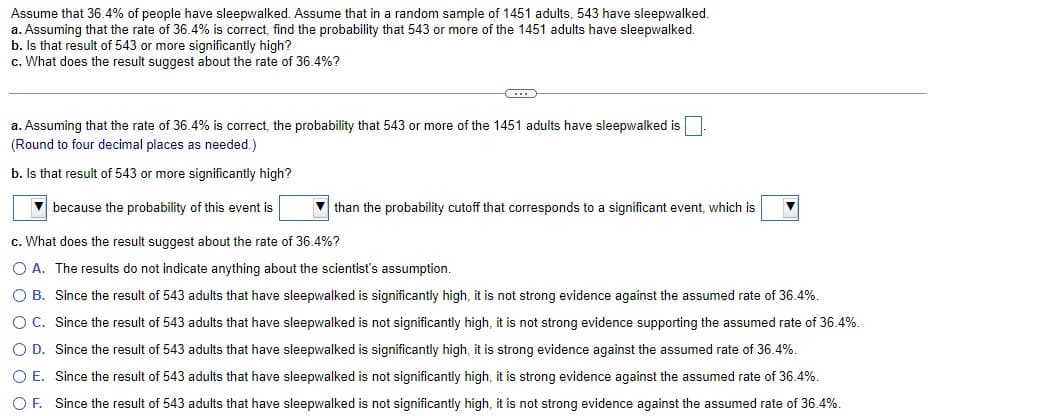Assume that 36.4% of people have sleepwalked. Assume that in a random sample of 1451 adults, 543 have sleepwalked. a. Assuming that the rate of 36.4% is correct, find the probability that 543 or more of the 1451 adults have sleepwalked. b. Is that result of 543 or more significantly high? c. What does the result suggest about the rate of 36.4%? CI a. Assuming that the rate of 36.4% is correct, the probability that 543 or more of the 1451 adults have sleepwalked is (Round to four decimal places as needed.) b. Is that result of 543 or more significantly high? because the probability of this event is c. What does the result suggest about the rate of 36.4%? O A. The results do not indicate anything about the scientist's assumption. O B. O C. Since the result of 543 adults that have sleepwalked is significantly high, it is not strong evidence against the assumed rate of 36.4%. Since the result of 543 adults that have sleepwalked is not significantly high, it is not strong evidence supporting the assumed rate of 36.4%. Since the result of 543 adults that have sleepwalked is significantly high, it is strong evidence against the assumed rate of 36.4%. O E. Since the result of 543 adults that have sleepwalked is not significantly high, it is strong evidence against the assumed rate of 36.4%. OF. Since the result of 543 adults that have sleepwalked is not significantly high, it is not strong evidence against the assumed rate of 36.4%. O D. than the probability cutoff that corresponds to a significant event, which is
Assume that 36.4% of people have sleepwalked. Assume that in a random sample of 1451 adults, 543 have sleepwalked. a. Assuming that the rate of 36.4% is correct, find the probability that 543 or more of the 1451 adults have sleepwalked. b. Is that result of 543 or more significantly high? c. What does the result suggest about the rate of 36.4%? CI a. Assuming that the rate of 36.4% is correct, the probability that 543 or more of the 1451 adults have sleepwalked is (Round to four decimal places as needed.) b. Is that result of 543 or more significantly high? because the probability of this event is c. What does the result suggest about the rate of 36.4%? O A. The results do not indicate anything about the scientist's assumption. O B. O C. Since the result of 543 adults that have sleepwalked is significantly high, it is not strong evidence against the assumed rate of 36.4%. Since the result of 543 adults that have sleepwalked is not significantly high, it is not strong evidence supporting the assumed rate of 36.4%. Since the result of 543 adults that have sleepwalked is significantly high, it is strong evidence against the assumed rate of 36.4%. O E. Since the result of 543 adults that have sleepwalked is not significantly high, it is strong evidence against the assumed rate of 36.4%. OF. Since the result of 543 adults that have sleepwalked is not significantly high, it is not strong evidence against the assumed rate of 36.4%. O D. than the probability cutoff that corresponds to a significant event, which is
Chapter8: Sequences, Series,and Probability
Section8.7: Probability
Problem 4ECP: Show that the probability of drawing a club at random from a standard deck of 52 playing cards is...
Related questions
Question
twinti6

Transcribed Image Text:Assume that 36.4% of people have sleepwalked. Assume that in a random sample of 1451 adults, 543 have sleepwalked.
a. Assuming that the rate of 36.4% is correct, find the probability that 543 or more of the 1451 adults have sleepwalked.
b. Is that result of 543 or more significantly high?
c. What does the result suggest about the rate of 36.4%?
a. Assuming that the rate of 36.4% is correct, the probability that 543 or more of the 1451 adults have sleepwalked is
(Round to four decimal places as needed.)
b. Is that result of 543 or more significantly high?
because the probability of this event is
c. What does the result suggest about the rate of 36.4%?
O A. The results do not indicate anything about the scientist's assumption.
O B. Since the result of 543 adults that have sleepwalked is significantly high, it is not strong evidence against the assumed rate of 36.4%.
Since the result of 543 adults that have sleepwalked is significantly high, it is strong evidence against the assumed rate of 36.4%.
O C. Since the result of 543 adults that have sleepwalked is not significantly high, it is not strong evidence supporting the assumed rate of 36.4%.
O D.
O E. Since the result of 543 adults that have sleepwalked is not significantly high, it is strong evidence against the assumed rate of 36.4%.
OF. Since the result of 543 adults that have sleepwalked is not significantly high, it is not strong evidence against the assumed rate of 36.4%.
than the probability cutoff that corresponds to a significant event, which is
Expert Solution
This question has been solved!
Explore an expertly crafted, step-by-step solution for a thorough understanding of key concepts.
Step by step
Solved in 6 steps with 16 images

Recommended textbooks for you

